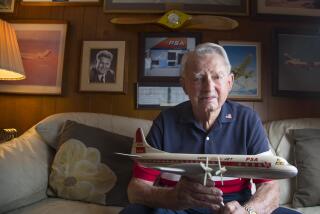Tiger Veteran Mourns Loss of a Proud Name
- Share via
NEW YORK — Friday was a sad day for Joe Rosbert of Franklin, N.C. That’s when he learned that the name Flying Tiger is likely to disappear from the airways of the world.
Tiger International, the owner of the Flying Tiger Line air cargo carrier, said Friday that it had agreed to be bought by Federal Express, a larger company that provides overnight delivery of small packages and documents throughout the United States and is expanding throughout the world.
But the 72-year-old Rosbert’s sadness was not rooted in any particular sentiment for the companies involved in the deal.
The Flying Tigers was the name of a famed World War II aerial combat unit with which he had risked his life battling the Japanese. Now, it appears that the name--and with it a piece of Americana--will fade away.
However, Rosbert said in a telephone interview Friday that as far as he is concerned, “that name will live forever. We were a group of men, all 24 and 25 years old, who had trained together and we fought together. There was a real camaraderie. I still have a soft spot for the outfit.”
Rosbert flew as a Flying Tigers fighter pilot in the first days of World War II. He was also one of the 10 veterans of that group who went on to found the cargo airline dubbed Flying Tigers right after the war ended in 1945. Though he was the carrier’s superintendent of flight operations, in the early days he also piloted an air freighter, he remembers.
Diminishing Ranks
The air cargo carrier was founded by a group headed by Robert W. Prescott, who had been a Navy pilot when he first heard about and volunteered for the original Flying Tigers.
Rosbert recalled Friday that 100 fighter pilots and 200 ground crew members were initially members of the group that fought with the Chinese against the Japanese. They still have annual reunions, but their ranks are dwindling. About 30 of the original pilots and 60 ground crewmen survive, Rosbert said.
The old Flying Tigers were formed in the early part of 1941 by a retired U.S. Army general, Claire Chennault. Its members were all volunteers--members of the U.S. military services who had to resign in order to join the group. Chennault had asked President Franklin D. Roosevelt for planes and men to help protect the Burma Road, the lifeline that brought supplies to the beleaguered armies of Chiang Kai-shek, the Nationalist Chinese leader.
As Rosbert recalls it, the group was in Burma still preparing to help the Chinese fight the Japanese--training, uncrating and assembling the P-40 fighter planes that had been shipped from the United States--when the Japanese attacked Pearl Harbor on Dec. 7.
Between Dec. 18, 1941, and July 4, 1942, when the outfit was officially disbanded, Flying Tiger pilots shot down a confirmed 286 Japanese planes plus another 300 probables. An estimated 1,500 enemy pilots, gunners, bombardiers and airmen were lost against a loss of only 24 Americans and 24 American planes.
Avoiding Dogfights
The reason for such success?
The young pilots followed Chennault’s dictum. “Never dogfight with a Japanese fighter or you will be killed.”
Martin Caidin, an author who specializes in World War II military aircraft subjects, said Friday that the Americans were able to avoid dogfights because the P-40s were able to dive faster than the Japanese Zeros that opposed them and had more firepower.
The Flying Tigers “fought brilliantly,” said Caidin, who lives in Gainesville, Fla. “They would get above the Japanese, making a diving attack and kept right on going. In a dogfight, they would have been dead meat.”
According to Caidin, the group’s official name was the American Volunteer Group. Newsmen dubbed them the Flying Tigers and the name stuck. Their P-40s bore sharks’ teeth painted on their noses and a flying tiger flying through a V painted on the sides.
When the group was disbanded, the men were reinstated to their original military ranks and either rejoined their units or joined a Chennault-led group that became part of the U.S. military forces. That unit eventually became the U.S. 14th Air Force.
But the Flying Tiger “name will never disappear,” Caidin said. “So long as people read and write history--and the Tigers are part of that history. The Tigers were a shining light in a long dark and stormy night.”
More to Read
Sign up for Essential California
The most important California stories and recommendations in your inbox every morning.
You may occasionally receive promotional content from the Los Angeles Times.













